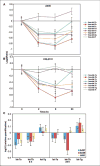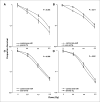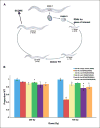MicroRNAs as potential agents to alter resistance to cytotoxic anticancer therapy
- PMID: 18056433
- PMCID: PMC6070379
- DOI: 10.1158/0008-5472.CAN-07-2858
MicroRNAs as potential agents to alter resistance to cytotoxic anticancer therapy
Abstract
Tumor cells use preexisting prosurvival signaling pathways to evade the damaging and cytotoxic effects of anticancer agents. Radiation therapy is a primary form of cytotoxic anticancer treatment, but agents that successfully modify the radiation response in vivo are lacking. MicroRNAs (miRNA) are global gene regulators that play critical roles in oncogenesis and have been found to regulate prosurvival pathways. However, there is little understanding of how cellular miRNA expression affects the response of a cancer to cytotoxic therapy and ultimately outcome. The let-7 family of miRNAs regulates expression of oncogenes, such as RAS, and is specifically down-regulated in many cancer subtypes. In fact, low levels of let-7 predict a poor outcome in lung cancer. Here, we report that the let-7 family of miRNAs is overrepresented in a class of miRNAs exhibiting altered expression in response to radiation. More strikingly, we also can create a radiosensitive state when the select let-7 family of miRNAs is overexpressed in vitro in lung cancer cells and in vivo in a Caenorhabditis elegans model of radiation-induced cell death, whereas decreasing their levels causes radioresistance. In C. elegans, we show that this is partly through control of the proto-oncogene homologue let-60/RAS and genes in the DNA damage response pathway. These findings are the first direct evidence that miRNAs can suppress resistance to anticancer cytotoxic therapy, a common feature of cancer cells, and suggest that miRNAs may be a viable tool to augment current cancer therapies.
Figures




References
-
- Yin E, Nelson DO, Coleman MA, Peterson LE, Wyrobek AJ. Gene expression changes in mouse brain after exposure to low-dose ionizing radiation. Int J Radiat Biol. 2003;79:759–75. - PubMed
-
- Esquela-Kerscher A, Slack FJ. Oncomirs—microRNAs with a role in cancer. Nat Rev Cancer. 2006;6:259–69. - PubMed
-
- Lee RC, Feinbaum RL, Ambros V. The C. elegans heterochronic gene lin-4 encodes small RNAs with antisense complementarity to lin-14. Cell. 1993;75:843–54. - PubMed
-
- Reinhart B, Slack F, Basson M, et al. The 21 nucleotide let-7 RNA regulates C. elegans developmental timing. Nature. 2000;403:901–6. - PubMed
-
- Lau NC, Lim LP, Weinstein EG, Bartel DP. An abundant class of tiny RNAs with probable regulatory roles in Caenorhabditis elegans. Science. 2001;294:858–62. - PubMed
Publication types
MeSH terms
Substances
Grants and funding
LinkOut - more resources
Full Text Sources
Other Literature Sources
Medical
Research Materials

